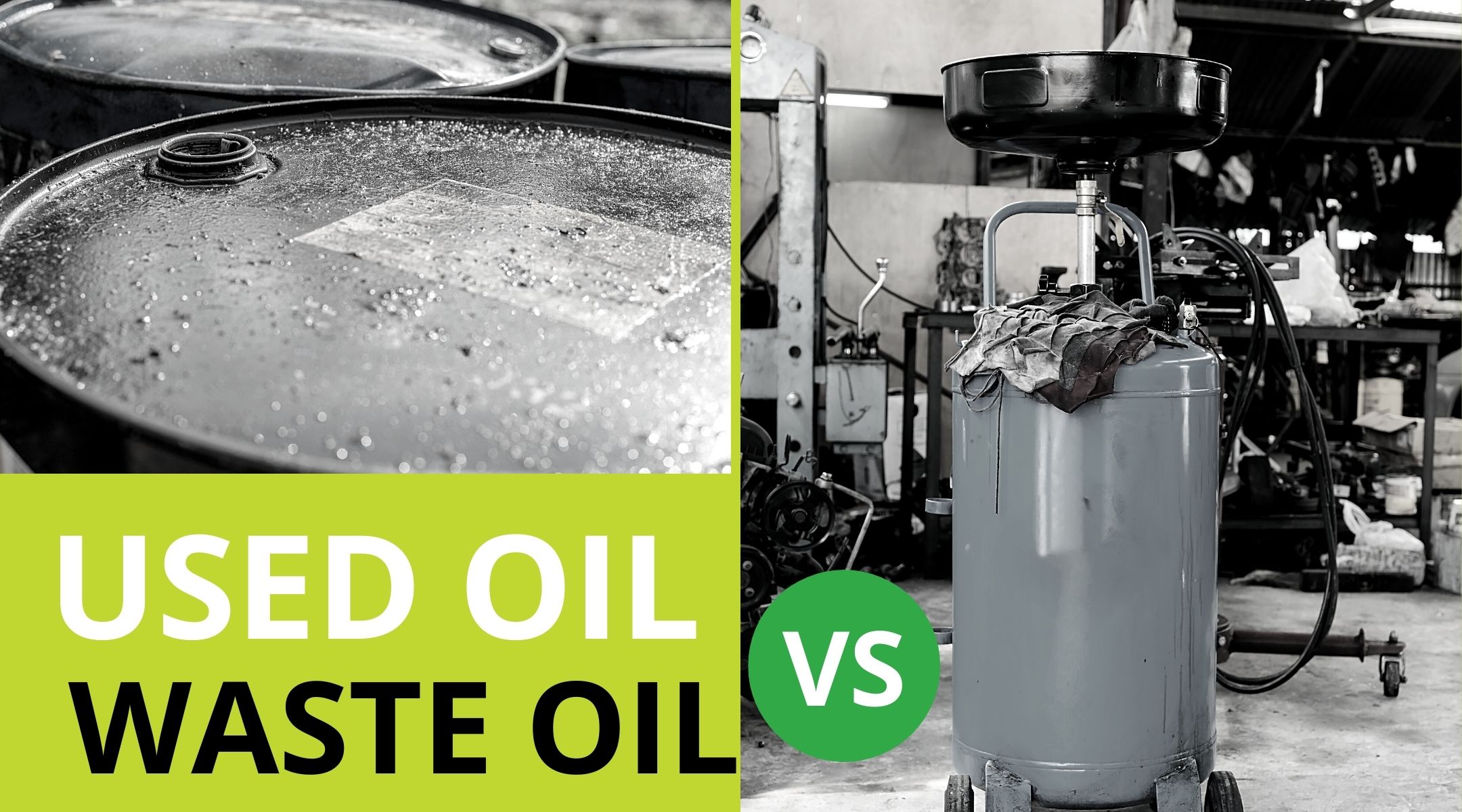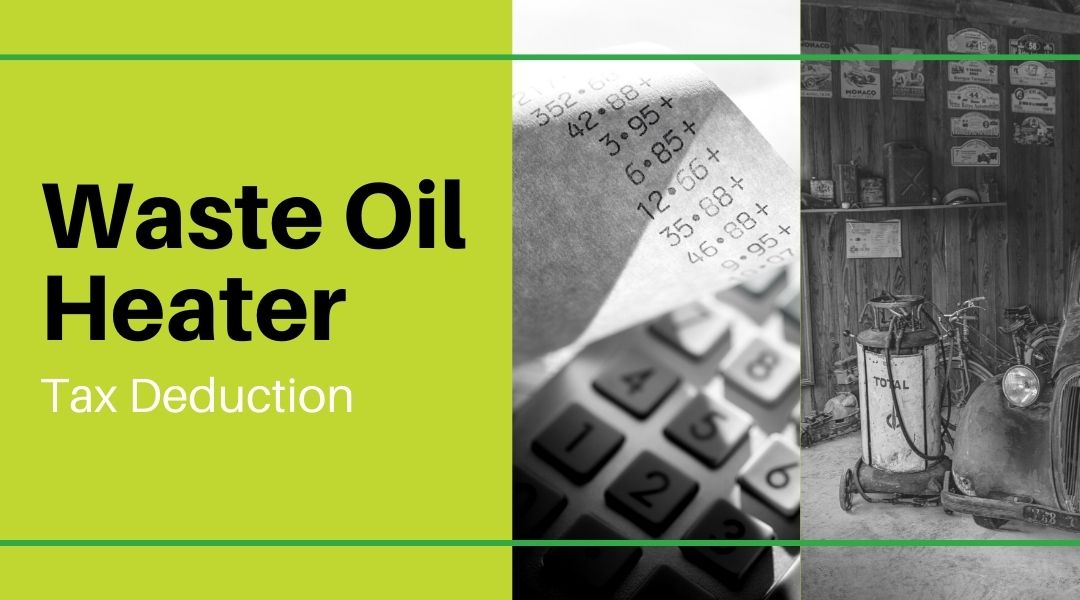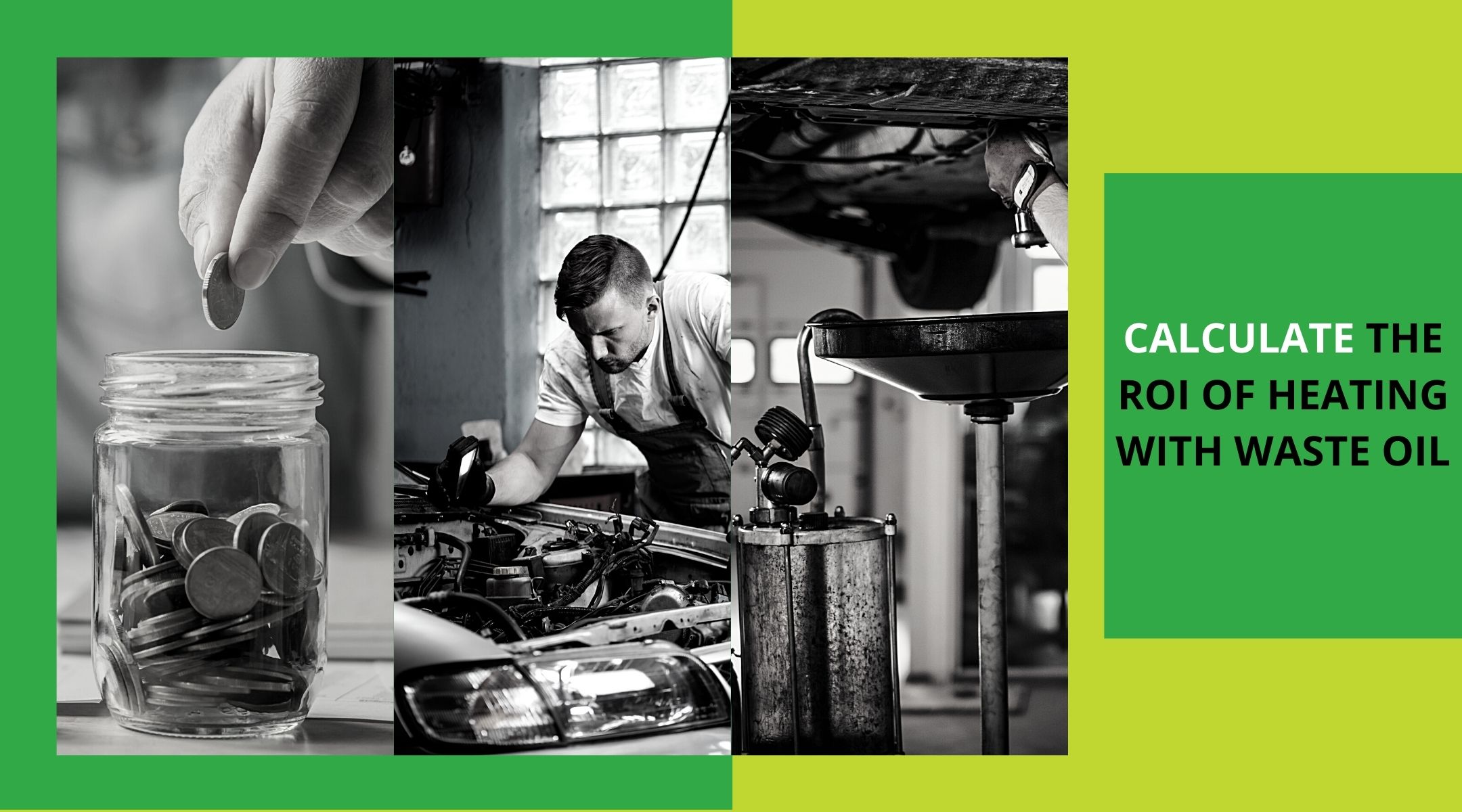What waste oil management standards must my business follow?
✅ In September 1992, the Environmental Protections Agency established management standards that all generators, transporters, burners, and processors of used oil must follow.
✅ Waste oil storage requirements include labelling tanks as ‘used oil’, keeping containers in good condition, and not mixing used oil with anything else.
✅ Waste oil transportation requirements include having an EPA-approved identification number and keeping records of acceptances and deliveries of used oil shipments.
✅ Waste oil transportation requirements include having an EPA-approved identification number and keeping records of acceptances and deliveries of used oil shipments.
✅ Waste oil burning requirements include only burning nonhazardous waste in an EPA-approved industrial furnace that vents combustion gases to the ambient air.
✅ EnergyLogic can help you understand your local waste oil management standards and provide a customized solution for burning waste oil for energy recovery.
Does your business generate or handle used oil as a byproduct of its operations? If so, there are regulatory practices that you must follow.
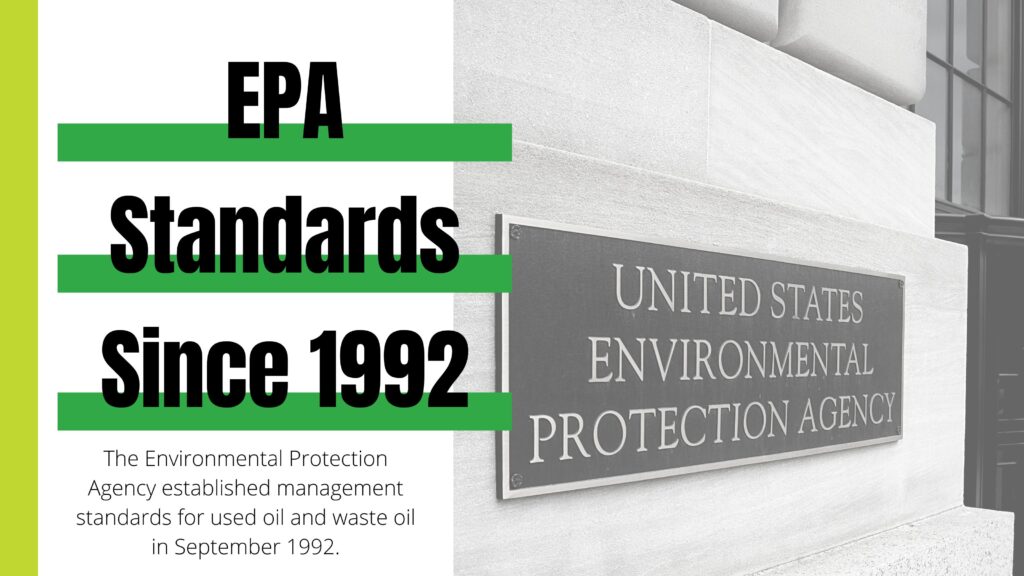
The Environmental Protection Agency established management standards for used oil and waste oil in September 1992. These good business practices were designed to encourage recycling, protect human health, and reduce environmental contamination. The waste oil management standards apply to all used oil generators and handlers, regardless of the amount of oil. So, whether you are a generator, transporter, burner, processor, or re-refiner of used oil, you must properly manage and dispose of waste oil.
Today, we look at what this entails, what waste oil management standards you must follow, and how to reduce your liability.
How Do I Know If My Business Generates Used Oil?
The EPA defines used oil as any petroleum-based or synthetic oil that has been used and therefore has become contaminated with impurities. Therefore, used oil is no longer fit for purpose and must be properly disposed of.
Used Oil Includes:
- Engine Oil
- Synthetic Oil
- Transmission Fluid
- Compressor Oil
- Refrigeration Oil
- Hydraulic Fluid
- Heat Transfer Fluid
- Oils Used as Buoyant
Used oil does not include virgin fuel oil recovered from a spill or bottom clean-out waste from virgin fuel oil storage tanks because they have not been contaminated. Other oils are also not considered used oils.
Used Oil Does Not Include:
- Bottom Clean-out Waste from Virgin Fuel Storage Tanks
- Virgin Fuel from Oil Spill Cleanups
- Antifreeze
- Kerosene
- Vegetable and animal oil, even when used as a lubricant
- Petroleum distillates used as solvents
The ‘What is Used Oil?’ reference table lists which oils fall under the definition of used oil. Any oil that the EPA defines as used oil must follow the waste oil management standards below.
What if My Business Just Handles Used Oil?
There is a common misconception that if your business doesn’t generate the used oil you are not required to adhere to the EPA’s waste oil management standards. In reality, all businesses that handle used oil are bound to the legal requirements for storage, transportation, recycling, and disposal. Therefore, if you are a used oil collection center, transporter, re-refiner, processor, or burner, you must also adhere to the used oil standards set out by the EPA.
The different types of businesses that may handle used oil:
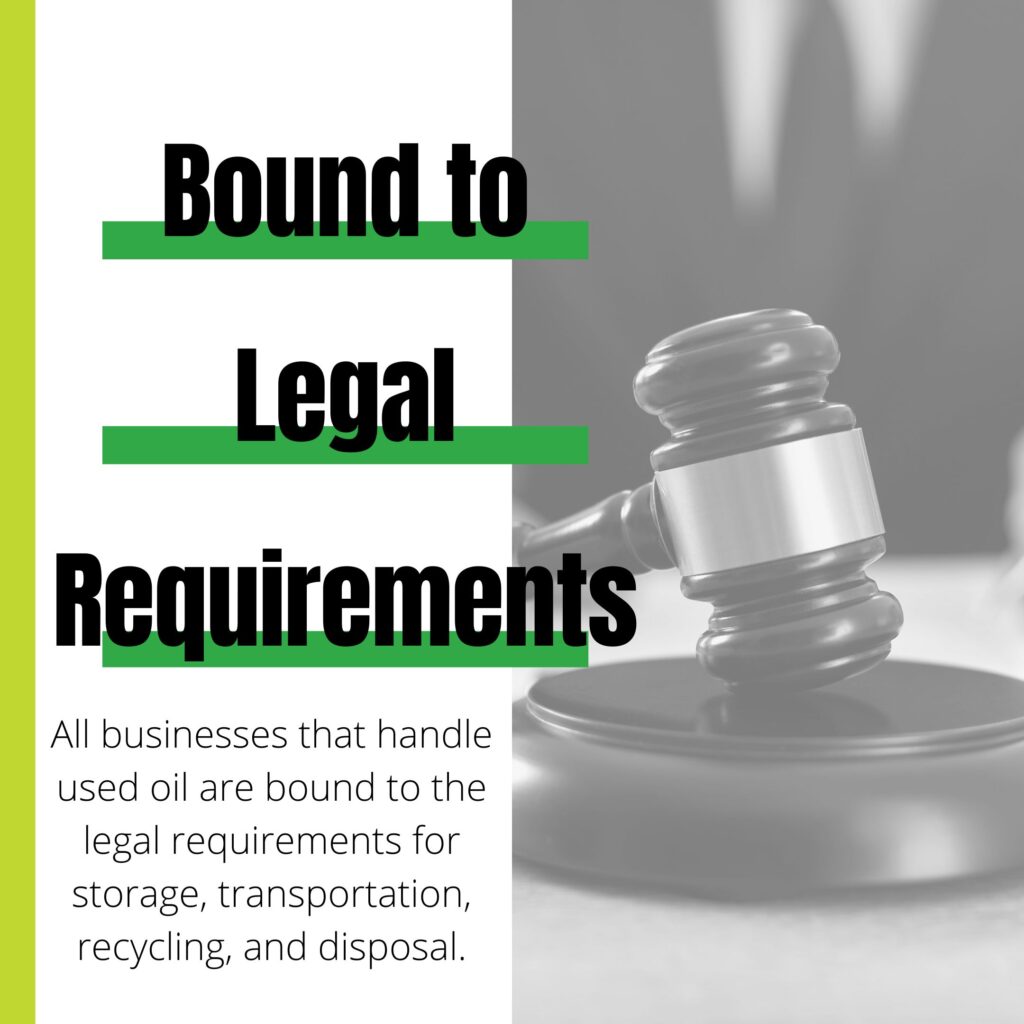
- Used Oil Collection Centers: Any facility that accepts used oil and stores it until it’s shipped elsewhere for recycling is considered a used oil collection center. Collection centers can accept used oil from businesses and/or individuals.
- Transporters: Any company that picks used oil from a generator and delivers it to a re-refiner, processor, or burner is considered a used oil transporter. A transporter may have a transfer facility that holds the used oil for between 24 hours and 35 days.
- Re-refiners and Processors: Any facility that blends or removes impurities from used oil to be reused or burned for energy recovery is considered a re-refiner or a processor.
- Burners: A burner heats used oil for energy recovery usually in a waste oil heater, waste oil boiler, industrial furnace, or hazardous waste incinerator.
What Used Oil Standards Must My Business Follow?
If your business generates or handles used oil, there are EPA waste oil management standards you must follow with regards to storage, cleaning up spills, transporting, recycling and burning.
Waste Oil Storage Requirements:
- Label containers and tanks as ‘Used Oil.’
- Keep containers and tanks in good condition without rust or leaks.
- Fix any structural defects in waste oil storage containers immediately.
- Never store used oil in anything other than approved tanks and storage containers.
- Re-refiners, processors, transfer facilities, and burners must have a secondary containment system (I.e., oil-impervious dike, berm, or retaining wall and a floor) so that oil cannot reach the environment if there is a leak or spill.
- Generators are encouraged to have a secondary containment system.
- Waste oil must be stored separately from all solvents and chemicals and not mixed with anything else. If mixed with hazardous waste, the oil must be managed as hazardous waste. The disposal of hazardous waste follows a very strict regulatory process that is lengthy and costly.
Waste Oil Leak and Spills Requirements:
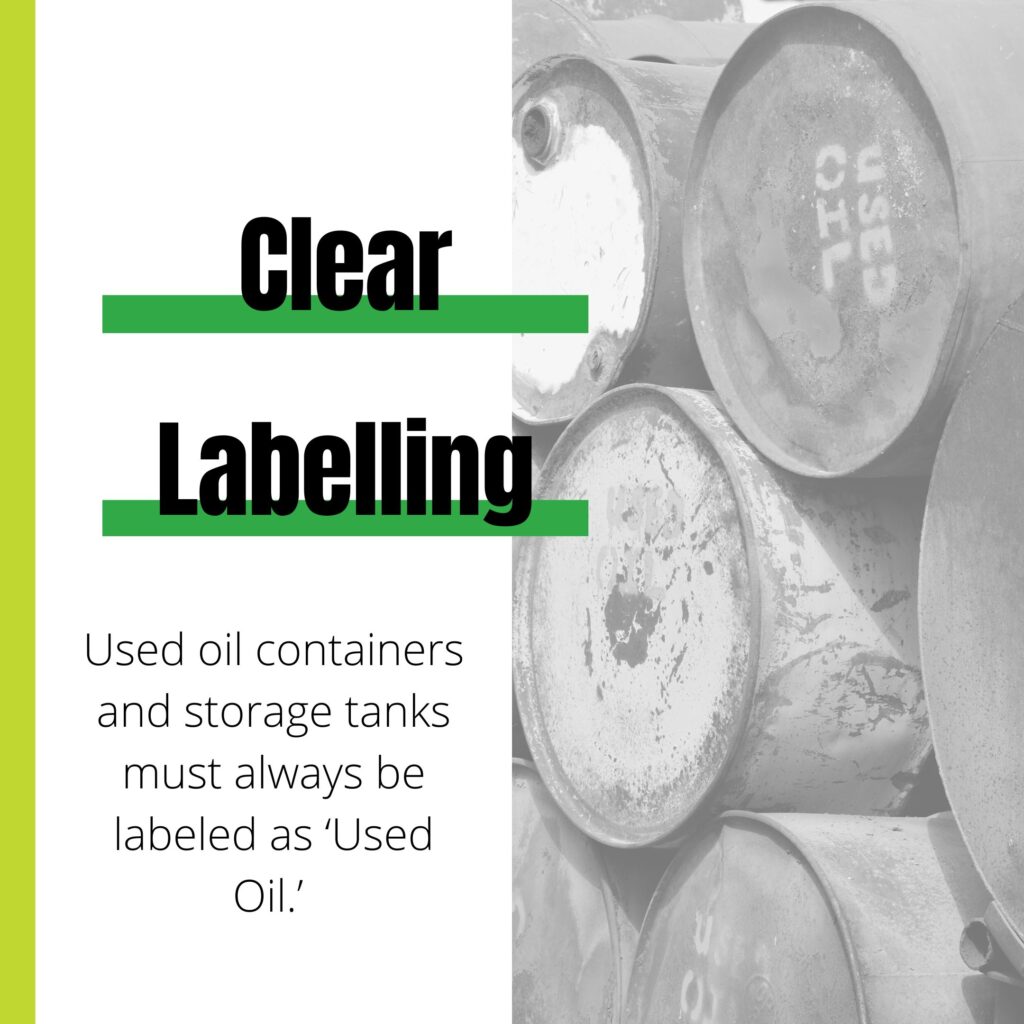
- Provide training on how to carefully transfer used oil to prevent leaks and spills.
- Keep absorbent materials on site in case of a spill.
- As soon as a spill or leak occurs, attempt to stop the oil from flowing at the source or put the oil in another tank.
- Contain the spilled oil as quickly as possible by erecting sorbent berms or spreading a sorbent of the oil.
- Clean up the oil and recycle the used oil as you would have before it was spilled.
- Oil that cannot be recycled must be disposed of appropriately.
- All cleanup materials, including rags to sorbent booms, must be disposed of as used oil according to the used oil management standards.
- The defective tank or container must be removed, repaired, or replaced immediately.
Waste Oil Transportation Requirements:
- All transporters that haul used oil must have a valid 12-digit EPA identification number.
- Generators, collection centers, and aggregations points must transport used oil in shipments over 55 gallons and must use waste oil transporters with a current EPA ID number valid for shipping used oil off-site.
- A record of acceptance and delivery of used oil shipments must be kept either in the form of a log, invoice, or shipping document and must be maintained for 3 years.
Waste Oil Recycling Requirements:
- Used oil can be reconditioned on-site by removing impurities from the waste oil and used again.
- Used oil can be transferred off-site to be re-refined by removing impurities from the oil and reusing it as a base stock for new lubricating oil.
- Used oil can be inserted into a petroleum refinery, which involves introducing used oil as feedstock into either the front end of the process or the cooker to produce gasoline.
- Used oil can be processed and burned for energy recovery as a fuel to generate heat or produce hot water.
Waste Oil Burning Requirements:
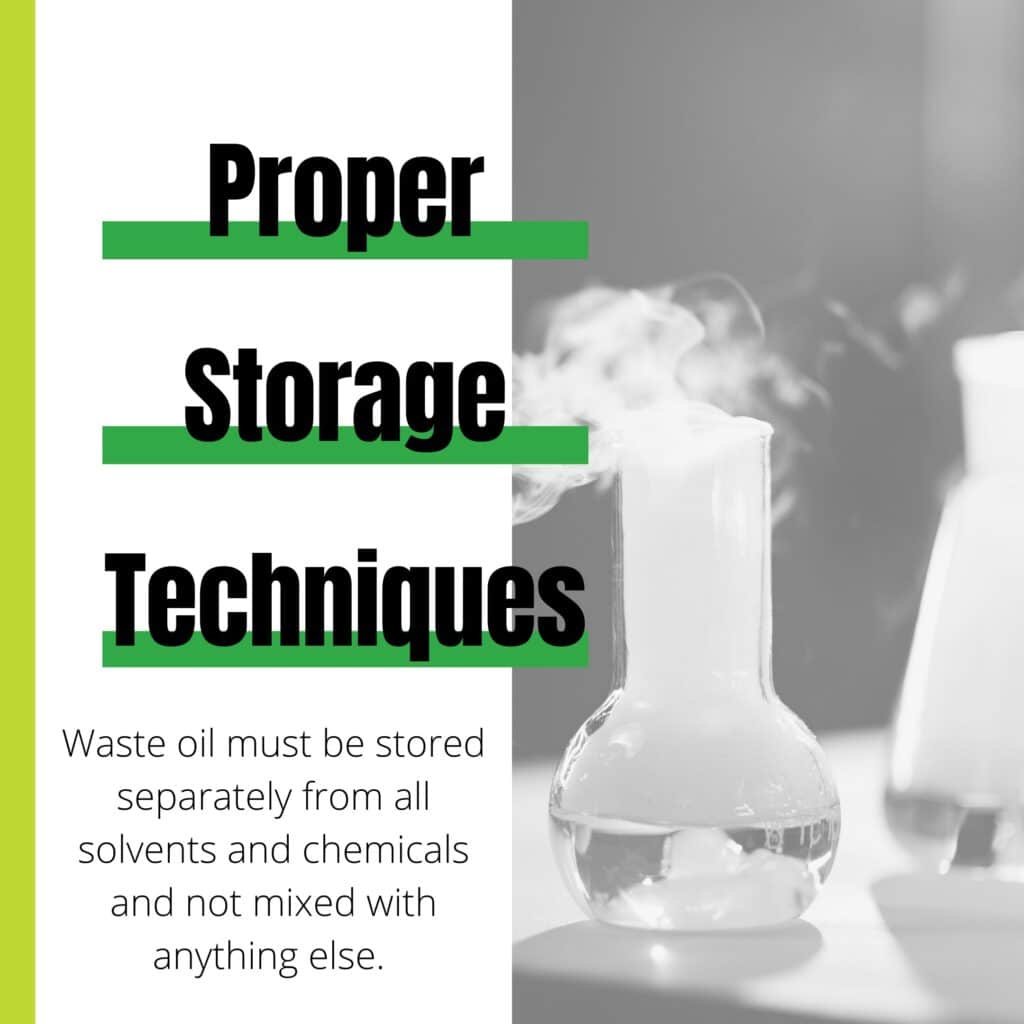
Waste oil burning requirements vary depending on if the used oil you generate and/or collect for energy recovery is Specification Used Oil or Off-Specification Used Oil.
On-Specification Used Oil Requirements:
If your used oil does not exceed any allowable levels of the constituents and properties shown on the EPA’s Used Oil Specifications Table. It can be burned for energy recovery in any device without US EPA restrictions as long as you follow these guidelines:
- You only burn the used oil that you, as the owner or operator, generates
- The heater has a maximum capacity of 0.5 million BTU per hour; and
- The combustion gases from the heater are vented to the ambient air.
Off-Specification Used Oil Requirements:
If your used oil is off specification, you can burn used oil for energy recovery as long as you follow these simple requirements:
- Only burn in an EPA-approved industrial furnace, boiler, or hazardous waste incinerator.
- Adhere to all the waste oil management standards outlined above.
- Ensure that used oil to be burned is not a hazardous waste by determining, documenting, and keeping records of the total halogen content.
- Vent combustion gases from the heater to the ambient air.
Know and Understand Your Local Waste Oil Management Standards
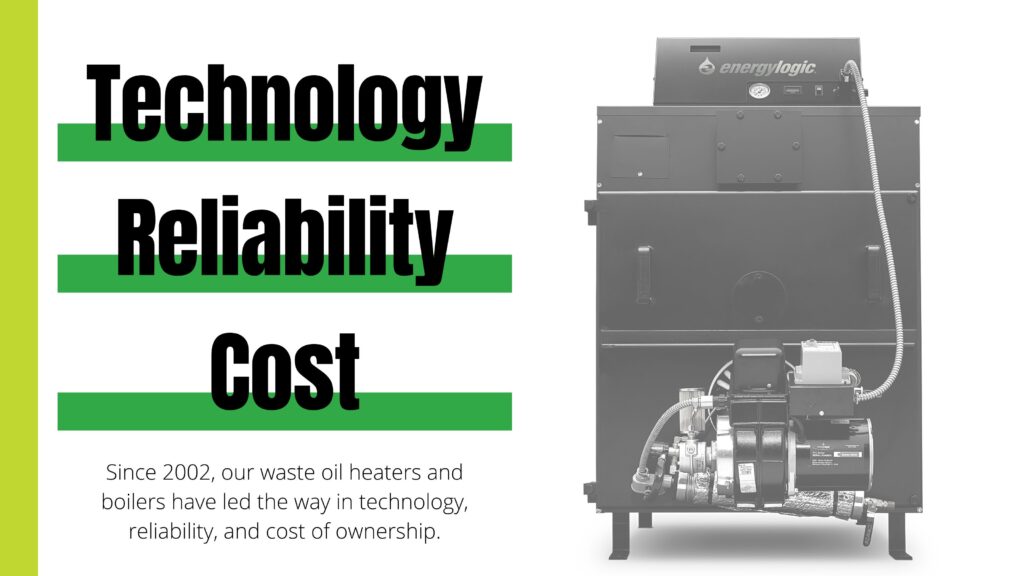
The waste oil management regulations outlined above are governed by the EPA and the country level. Your state and local waste oil management standards may be stricter than the EPA’s. Therefore, it is always advised to contact our state or local environmental agency to determine the best course of action.
Alternatively, if you are interested in burning waste oil for energy recovery, then contact EnergyLogic. Since 2002, our waste oil heaters and boilers have led the way in technology, reliability, and cost of ownership. Our national network of experts, along with our in-house support team, can guide you to the best custom solution to harness your onsite energy and reduce costs. Give us a call today!
Sources:
https://www.epa.gov/hw/managing-used-oil-answers-frequent-questions-businesses
The Used Oil Management Standards
https://iwrc.uni.edu/sites/default/files/UsedOil_June2015.pdf
https://www.epa.gov/hw/managing-used-oil-answers-frequent-questions-businesses#regulatory
https://www.ecfr.gov/current/title-40/chapter-I/subchapter-I/part-279?toc=1
https://danielstraining.com/us-epa-regulations-for-the-management-of-used-oil/
The Latest Innovation in Small Space Heating
Meet the EL 75H

Why our customers love us

Learn More about Waste Oil
Waste Oil Savings Calculator
Find Your Custom Solution - Start Here
Burn Waste Oil and Save:
Savings Per Year:(values in USD)
$ †Custom
10-year Savings(after equipment cost)
$ †Custom
An EnergyLogic Waste Oil Heater Pays for Itself in Only:
Years †Custom

†Custom: Is your facility not represented here?
Click Get Your Custom Quote to contact EnergyLogic for custom solution.
Information based on U.S. Energy Information Administration. *Based on insulated space with 16ft. ceiling. Results may vary based on geographical & other considerations.
You're making the best decision in waste oil heating.
Thank you for your interest in EnergyLogic!
An EnergyLogic Rep will be in contact within 1-2 business days to help you find the perfect heating solution for your facility.
Discover the Right Questions to Ask.
Download our Buyer's Guide, and be informed with insider industry knowledge.


